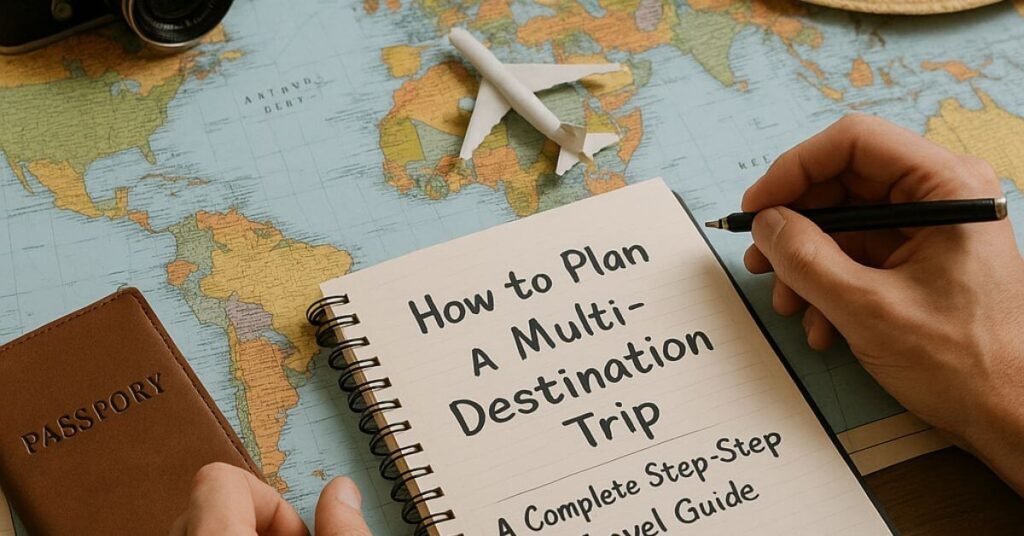Planning a trip to multiple destinations can be one of the most exciting and rewarding ways to travel. Whether you’re exploring several countries in Europe, combining cities across Southeast Asia, or mapping out a road trip through the U.S., the idea of experiencing many places in one journey is thrilling. But with that excitement comes complexity — more logistics, decisions, and potential pitfalls.
In this article, you’ll learn exactly how to plan a successful multi-destination trip — from route planning and budgeting to accommodation tips and smart booking strategies.
Why Choose a Multi-Destination Trip?
A multi-destination itinerary allows you to experience more in one trip. You can explore different cultures, climates, cuisines, and landscapes — often with more cost efficiency than taking multiple shorter trips.
Some of the top benefits include:
- Maximizing time off by visiting several places in one go
- Taking advantage of cheaper regional flights or rail passes
- Seeing how different cultures connect and contrast
- Increasing your travel value through smart routing
- Customizing your journey for a truly unique adventure
However, a well-thought-out plan is essential. Without it, you risk burnout, over-spending, or wasting time in transit.
Step 1: Choose the Regions or Countries You Want to Visit
Start by identifying the broad regions you’re interested in. Ask yourself:
- Do I want beaches, mountains, cities, or historical sites?
- What’s my total travel time and budget?
- Is there a specific theme (like food, history, or adventure)?
- Are there visa or vaccination requirements?
Popular multi-destination trip ideas include:
- Western Europe (France, Germany, Netherlands, Spain)
- Southeast Asia (Thailand, Vietnam, Cambodia, Laos)
- USA Road Trip (California to New York or the Pacific Northwest)
- South America (Peru, Chile, Argentina, Bolivia)
- Africa Safari Circuit (Kenya, Tanzania, South Africa)
Be realistic with your timeframe — it’s better to go deeper in fewer places than to rush through too many.
Step 2: Map Out a Logical Route
Once you’ve chosen your countries or regions, map them out geographically. This avoids unnecessary backtracking and saves you time and money.
Use tools like:
- Google Maps
- Rome2Rio
- Skyscanner’s Multi-City Tool
- Omio for European rail and buses
Consider routes that go in one direction — for example, north to south or clockwise — and try to fly into your starting point and out of your final destination (open-jaw flights).
Example: Instead of Paris > Rome > Amsterdam > Barcelona, choose Paris > Amsterdam > Rome > Barcelona to follow a more efficient path.
Step 3: Set a Travel Budget and Daily Spending Goals
Budgeting is crucial. Your costs will vary depending on the region, transport, accommodations, and activities.
Key expenses include:
- Flights (international and regional)
- Accommodation
- Daily food
- Attractions or tours
- Insurance
- Transportation (trains, buses, taxis)
- Visas and vaccines
- Souvenirs or shopping
Create a spreadsheet and assign a daily spending limit per city. For example:
- Western Europe: $80–150/day
- Southeast Asia: $30–60/day
- North America: $90–200/day
- South America: $50–100/day
Use tools like Numbeo or BudgetYourTrip to research average daily costs in each destination.
Step 4: Decide How Long to Stay in Each Destination
This is one of the trickiest parts. Consider:
- The size of the destination
- The number of attractions you want to see
- Travel fatigue and rest days
- Transit time between places
A good rule of thumb:
- Big cities: 3–5 nights
- Smaller towns: 1–2 nights
- Nature or adventure stops: 2–4 nights
Include buffer days in your schedule. You’ll thank yourself when travel delays or spontaneous plans arise.
Step 5: Book Flights and Long-Distance Transportation
Start with your international flights. Search using:
- Skyscanner
- Google Flights
- Hopper
Once your entry and exit points are booked, fill in the gaps:
- Regional flights: AirAsia, Ryanair, EasyJet
- Trains: Eurail, Amtrak, JR Pass (Japan)
- Buses: Flixbus, Megabus, Greyhound
For road trips, plan your driving time carefully and look into one-way car rentals or campervans.
Pro tip: Avoid scheduling long-haul transport on back-to-back days. You need recovery time.
Step 6: Choose Accommodations Strategically
Accommodation for multi-destination trips needs to balance cost, location, and comfort. Use platforms like:
- Booking.com (free cancellation)
- Airbnb (great for longer stays)
- Hostelworld (budget-friendly and social)
- Agoda (especially good for Asia)
Filter by:
- Proximity to transportation (bus/train stations)
- Wi-Fi quality (if you work remotely)
- Safety and walkability
- Reviews and cleanliness
If you’re traveling for several weeks or months, consider staying in places that offer discounts for longer stays.
Step 7: Pack Light but Smart
Packing for multiple climates and cultures is tricky, but manageable. Bring:
- Lightweight clothing layers
- One pair of versatile shoes
- Travel adapter and power bank
- Documents and copies
- Toiletries in travel-size bottles
- Reusable water bottle
Use packing cubes and only take what you truly need. You can always buy items on the road.
Remember: most people overpack and regret it. Travel light for more flexibility.
Step 8: Organize All Your Travel Details
Once your bookings are made, keep all details in one place:
- Create a Google Sheet with your itinerary
- Use apps like TripIt or Notion for organizing bookings
- Screenshot or print key confirmations (hotels, tours, flights)
- Download offline maps for each city
- Join Facebook groups or Reddit threads for each destination
Have a backup copy of your passport and travel insurance stored securely online.
Step 9: Plan Activities and Free Time
Balance structure with flexibility. Don’t overbook your days — leave time for:
- Wandering neighborhoods
- Unexpected discoveries
- Meeting other travelers
- Delays or tired days
Book key attractions in advance (like Alhambra in Spain or Machu Picchu in Peru), but don’t fill every hour.
Use local tourism websites, Google reviews, and walking tour companies for ideas.
Step 10: Prepare for the Unexpected
No matter how well you plan, things will go wrong. Build in margin for:
- Missed buses or trains
- Illness or fatigue
- Political unrest or strikes
- Sudden closures (especially in off-season)
Bring extra copies of documents and a small emergency fund ($300–$500 in cash). Stay calm and adaptable — it’s all part of the adventure.
Mistakes to Avoid When Planning Multi-Stop Trips
- Booking too many destinations in too little time
- Underestimating transit time or cost
- Not checking visa requirements for each country
- Ignoring travel insurance
- Skipping over rest days
- Traveling during local holidays without preparation
- Not budgeting for food, tipping, or hidden costs
Every mistake above has cost someone time, money, or joy. Avoid them by staying aware and realistic.
Tools to Simplify Your Planning
Modern tools make multi-destination trips easier than ever. Try:
- Rome2Rio for routes between any two locations
- Kayak Explore to find destination ideas by budget
- TravelSpreadsheets (free templates online)
- Google Calendar for syncing plans and activities
- Trello Boards for collaborative planning
And most importantly: keep all travel confirmations in email folders or TripIt.
Final Thoughts: Enjoy the Journey, Not Just the Destinations
Multi-destination travel is one of the most fulfilling ways to explore the world. You’ll collect a collage of cultures, landscapes, and experiences that stay with you for life.
But the key to success lies in smart, intentional planning — not perfection. Use tools, stay organized, but don’t stress every detail. The best moments are often the ones you didn’t plan.
So pack your bags, map your route, and step into your global adventure with confidence. The world is waiting.
Elaine A. da Silva is a Brazilian travel and finance enthusiast, best known as the creator of the blog Dica das Milhas. With a strong background in personal finance and a passion for exploring smart travel strategies, she specializes in simplifying the world of airline miles and travel rewards for everyday people. Through her blog, Elaine shares practical tips, insider knowledge, and step-by-step guides to help readers save money and travel more efficiently using loyalty programs and credit card points.







